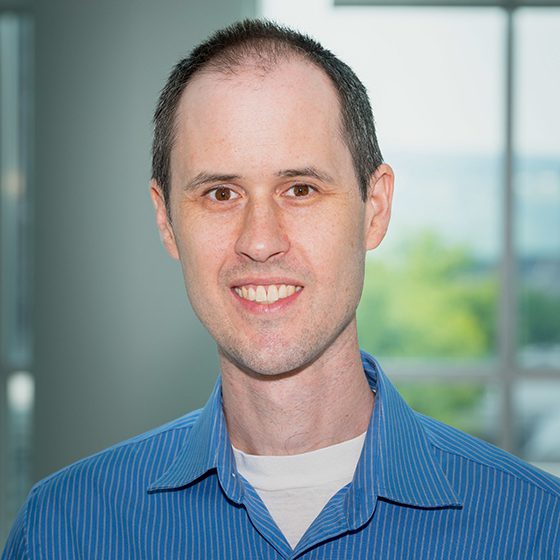
- Graduate Field Affiliations
- Applied Physics
- Physics
Biography
Fuchs earned his Ph.D. in Applied Physics from Cornell University in 2007. Afterward, he moved to the University of California, Santa Barbara as a postdoctoral associate. In 2011, he joined the Cornell faculty of Applied and Engineering Physics. In 2012 he received a Young Investigator Award from the Air Force Office of Scientific Research, in 2013 he received an Early Faculty Career Award from the National Science Foundation along with the Presidential Early Career Award for Scientists and Engineers, and in 2014 he received the Early Career Award from the Department of Energy.
Research Interests
The Fuchs Group focuses on quantum information science and spintronics. We study and manipulate spin and optical degrees of freedom in solid-state materials. Although we are primarily a condensed matter physics research group, we draw inspiration from many fields including atomic physics, materials science, and electrical engineering.
We are interested in hybrid quantum systems, in which disparate degrees of freedom interact coherently. Such systems can form the basis of future quantum technologies such as quantum repeaters and quantum transducers. Diamond nitrogen-vacancy (NV) defect centers are an important platform for our research because they possess a coherent optical transition, long-lived spin coherence, and several mechanisms for coupling to external degrees of freedom – mechanical, magnetic, and electrical. NV center-based hybrid systems form outstanding quantum-enhanced sensors for a range of applications from nanoscience to navigation and they can form the backbone of a quantum network. In addition to diamond NV centers, also examine emerging defect centers in wide band-gap materials for quantum applications.
In an emerging research area within the group, we are interested in a hybrid quantum system based on superconducting microwave circuits and ultra-low damping magnetic materials. We have recently demonstrated the integration of these two disparate elements in a way that allows us to design waveguides microwave photons and magnons on an equal basis, enabling controlled and strong interactions. We are interested in using these structures for a variety of experiments ranging from the demonstration of nonreciprocal quantum circuit elements to the creation of quantum states of magnons.
Another focus is understanding spins and spin dynamics in materials to enable future technologies based on spin. We are interested in spin-orbit torques and exotic spin order including antiferromagnetic, multiferroic, and chiral magnetic materials. One important tool in our research is the time-resolved magneto-thermal microscope — a unique table-top magnetic microscope that we have developed over the past several years. Our approach is surprisingly versatile: we have imaged spin texture in magnetic metals, magnetic insulators, antiferromagnetic metals, and antiferromagnetic insulators. In recent years, we have also built a scanning NV center microscope as another versatile tool for studying magnetic materials and devices. This microscope leverages quantum sensing protocols to acquire images of the NV center’s spin response to magnetic fields and magnetic fluctuations that originate from a sample with ~50 nm resolution. So far, we have used it to study canted antiferromagnetic materials and devices.
- Nanotechnology
- Condensed Matter and Material Physics
- Optical Physics
- Quantum Information Science
Select Publications
-
I. Gray, T. Moriyama, N. Sivadas, G. M. Stiehl, J. T. Heron, R. Need, B. J. Kirby, D. H. Low, K. C. Nowack, D. G. Schlom, D. C. Ralph, T. Ono, and G. D. Fuchs. “Spin Seebeck imaging of spin-torque switching in antiferromagnetic Pt/NiO heterostructures.” Physical Review X 9: 041016. 2019.
-
H. Chen, N. F. Opondo, B. Jiang, E. R. MacQuarrie, R. S. Daveau, S. A. Bhave, and G. D. Fuchs. “Engineering electron-phonon coupling of quantum defects to a semi-confocal acoustic resonator.” Nano Letters 19: 7021-7027. 2019.
-
C. Zhang, J. M. Bartell, J. C. Karsch, I. Gray, and G. D. Fuchs. “Nanoscale Magnetization and Current Imaging Using Time-Resolved Scanning-Probe Magnetothermal Microscopy,” Nano Letters, 21: 4966-4972. 2021.
-
N. Mathur, A. Mukherjee, X. Gao, J. Luo, B. A. McCullian, T. Li, A. N. Vamivakas, and G. D. Fuchs. “Excited-state spin-resonance spectroscopy of VB– defect centers in hexagonal boron nitride,” Nature Communications 13: 3233. 2022.
-
B. A. McCullian, H. F. H. Cheung, H. Y. Chen, and G. D. Fuchs. “Quantifying the Spectral Diffusion of N-V Centers by Symmetry,” Physical Review Applied 18: 064011. 2022.
Select Awards and Honors
- Cornell Engineering Research Excellence Award 2020
- Early Career Research Program Awardee, Department of Energy 2014
- Presidential Early Career Award for Scientists and Engineers, Air Force Office of Scientific Research 2013
- Faculty Early Career Award, National Science Foundation 2013
- Rebecca Q. and James C. Morgan Sesquicentennial Faculty Fellow, Cornell University 2012
Education
- B.S., Physics and Chemistry Education, University of Wisconsin-Madison,1996 1996
- M.S., Applied Physics, Cornell University 2003
- Ph.D., Applied Physics, Cornell University 2007
